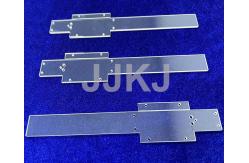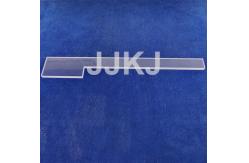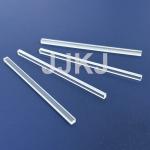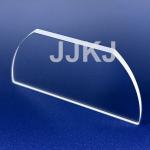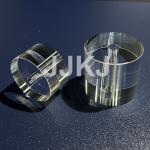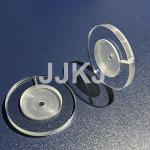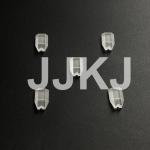Sapphire Materials:
Sapphire is grown using various different methods, each with its
advantages. By offering Sapphire grown by Stepanov, Czochralski,
Kryopolus and HDSM methods, Roditi ensure that the specification is
met with the best production time and cost in mind.
Boules, Ingots and Blanks
Unprocessed, single crystal Sapphire takes the form of a boule
before being cut and polished into the required forms.
The boule is a large, cylindrical-like piece of Sapphire with no
ground, polished or flat faces and offers any crystallographic
orientation of components, such as c, m, r and a-cut. Because of
Sapphire's tremendous hardness, the cutting and processing is done
with diamond tools.
Boules such as this are processed into blanks and ingots ready for
further processing and polishing. Such blanks and ingots are
uniformly shaped, usually as cylinders, and have ground surfaces.
Sapphire Optical window Specifications:
| Name | Sapphire Optical window |
| Material | Sapphire single crystal |
| Orientation | C-axis |
| Hardness | Mohs 9 |
| Length | 1-500 mm |
| Length tolerance | ±0.05 mm |
| Thickness | 0.1-100 mm |
| Thickness tolerance | ±0.05 mm |
| Parallelism | ≤3 ARC Min |
| Surface quality | Double Side Polisehd 60/40 |
| Chamfer | 0.1-0.5mm*45 degree |
| Clear Aperture | 90% |
| Coating | According to customer needs |
Sapphire optical components' properties:
1.High Hardness:Sapphire is one of the hardest known materials, second only to
diamond on the Mohs scale. This hardness makes sapphire optical
components resistant to scratching and abrasion, ensuring long-term
durability and reliability.
2.Excellent Optical Transparency:Sapphire exhibits exceptional optical transparency across a wide
spectrum, from ultraviolet (UV) to near-infrared (NIR) wavelengths.
This property allows sapphire optics to transmit light with minimal
absorption or scattering, making them suitable for various optical
applications.
3.Chemical Stability:Sapphire is chemically inert and resistant to corrosion, even when
exposed to harsh chemicals and environments. This stability ensures
that sapphire optical components maintain their optical performance
over time, making them suitable for use in challenging conditions.
4.High Thermal Conductivity:Sapphire possesses high thermal conductivity, allowing it to
efficiently dissipate heat generated during operation. This
property helps prevent thermal distortion and ensures optical
stability, particularly in high-power laser applications.
5.Wide Temperature Range:Sapphire optical components can withstand a broad temperature
range, from cryogenic temperatures to high temperatures exceeding
2000°C. This thermal stability makes sapphire optics suitable for
use in extreme environments, such as space exploration and
industrial processes.
6.Low Fluorescence: Sapphire exhibits minimal fluorescence when exposed to certain
wavelengths of light, making it suitable for fluorescence
microscopy and other applications requiring low background noise.
7.High Mechanical Strength: In addition to its hardness, sapphire also possesses high
mechanical strength, allowing it to withstand mechanical stress and
pressure without deformation or breakage.
8.Biocompatibility: Sapphire is biocompatible and non-toxic, making it suitable for use
in medical devices and biomedical applications where optical
clarity and compatibility with biological tissues are essential.
FAQ:
Q:What is your minimum order requirement?
A:MOQ: 10 pieces
Q:How long will it take to execute my order ?
A:10-25 days after confirming the payment.
Q:Can you give warranty of your products ?
A:We promise the quality, if the quality has any problems, we will
produce new produces or return you money.
Q:How to pay?
A:T/T, Paypal, West Union,etc.
Q:Can you produce custom optics?
A:Yes, we can produce custom optics

